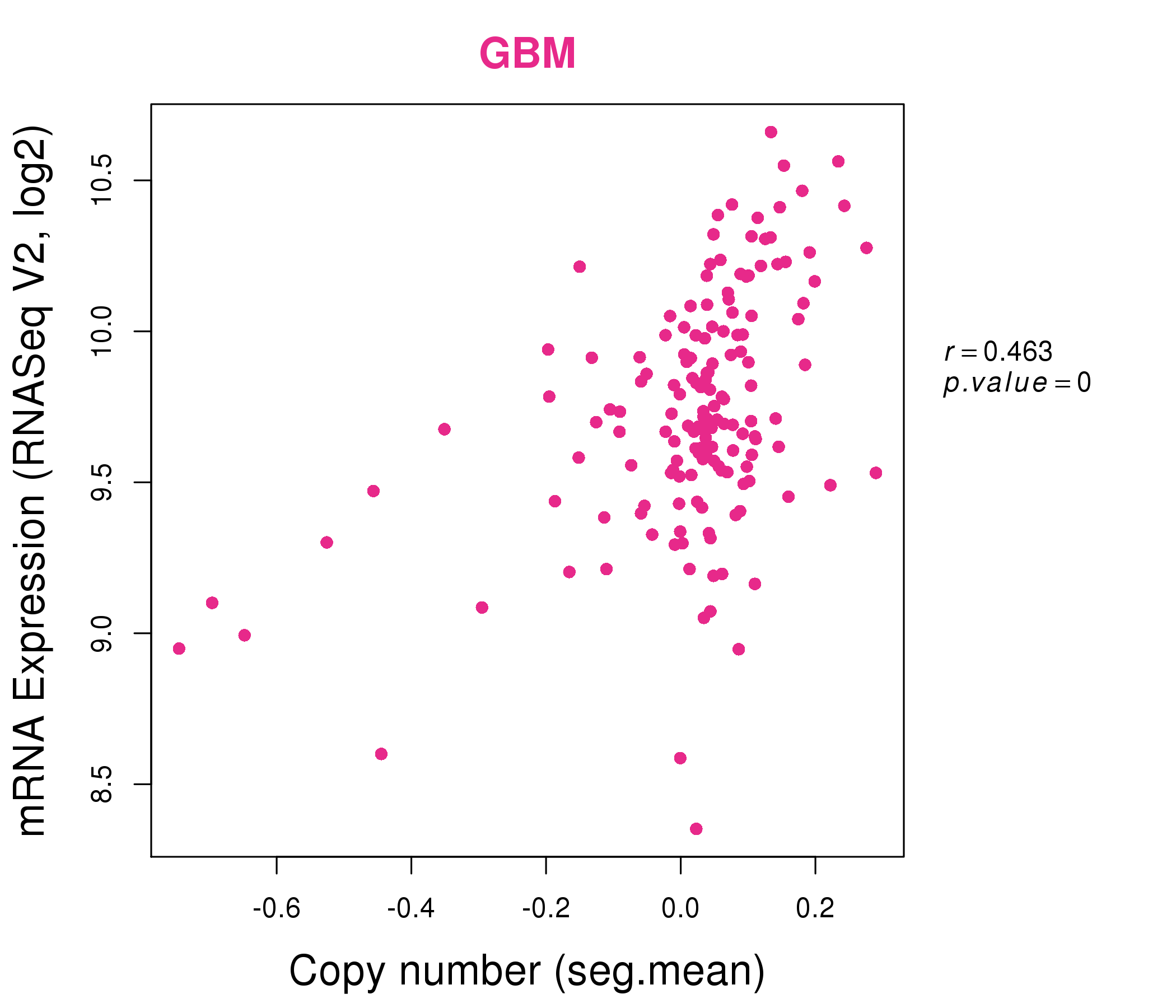|
||||||||||||||||||||||||||||||||||||||||||||||||||||||||||||||||||||||||||||||||||||||||||||||||||||||||||||||||||||||||||||||||||||||||||||||||||||||||||||||||||||||||||||||||||||||||||||||||||||||||||||||||||||||||||||||||||||||||||||||||||||||||||||||||||||||||||||||||||||||||||||||||||||||||||||||||||||||||||
| |
| Phenotypic Information (metabolism pathway, cancer, disease, phenome) |
| |
| |
| Gene-Gene Network Information: Co-Expression Network, Interacting Genes & KEGG |
| |
|
| Gene Summary for PARN |
| Basic gene info. | Gene symbol | PARN |
| Gene name | poly(A)-specific ribonuclease | |
| Synonyms | DAN | |
| Cytomap | UCSC genome browser: 16p13 | |
| Genomic location | chr16 :14529556-14724128 | |
| Type of gene | protein-coding | |
| RefGenes | NM_001134477.2, NM_001242992.1,NM_002582.3, | |
| Ensembl id | ENSG00000140694 | |
| Description | deadenylating nucleasedeadenylation nucleasepoly(A)-specific ribonuclease (deadenylation nuclease)poly(A)-specific ribonuclease PARNpolyadenylate-specific ribonuclease | |
| Modification date | 20141207 | |
| dbXrefs | MIM : 604212 | |
| HGNC : HGNC | ||
| Ensembl : ENSG00000140694 | ||
| HPRD : 07250 | ||
| Vega : OTTHUMG00000173199 | ||
| Protein | UniProt: O95453 go to UniProt's Cross Reference DB Table | |
| Expression | CleanEX: HS_PARN | |
| BioGPS: 5073 | ||
| Gene Expression Atlas: ENSG00000140694 | ||
| The Human Protein Atlas: ENSG00000140694 | ||
| Pathway | NCI Pathway Interaction Database: PARN | |
| KEGG: PARN | ||
| REACTOME: PARN | ||
| ConsensusPathDB | ||
| Pathway Commons: PARN | ||
| Metabolism | MetaCyc: PARN | |
| HUMANCyc: PARN | ||
| Regulation | Ensembl's Regulation: ENSG00000140694 | |
| miRBase: chr16 :14,529,556-14,724,128 | ||
| TargetScan: NM_001134477 | ||
| cisRED: ENSG00000140694 | ||
| Context | iHOP: PARN | |
| cancer metabolism search in PubMed: PARN | ||
| UCL Cancer Institute: PARN | ||
| Assigned class in ccmGDB | A - This gene has a literature evidence and it belongs to cancer gene. | |
| References showing role of PARN in cancer cell metabolism | 1. AA Balatsos N, Maragozidis P, Anastasakis D, Stathopoulos C (2012) Modulation of poly (A)-specific ribonuclease (PARN): current knowledge and perspectives. Current medicinal chemistry 19: 4838-4849. go to article | |
| Top |
| Phenotypic Information for PARN(metabolism pathway, cancer, disease, phenome) |
| Cancer | CGAP: PARN |
| Familial Cancer Database: PARN | |
| * This gene is included in those cancer gene databases. |
|
|
|
|
|
|
| ||||||||||||||||||||||||||||||||||||||||||||||||||||||||||||||||||||||||||||||||||||||||||||||||||||||||||||||||||||||||||||||||||||||||||||||||||||||||||||||||||||||||||||||||||||||||||||||||||||||||||||||||||||||||||||||||||||||||||||||||||||||||||||||||||||||||||||||||||||||||||||||||||||||||||||||||||||
Oncogene 1 | Significant driver gene in | |||||||||||||||||||||||||||||||||||||||||||||||||||||||||||||||||||||||||||||||||||||||||||||||||||||||||||||||||||||||||||||||||||||||||||||||||||||||||||||||||||||||||||||||||||||||||||||||||||||||||||||||||||||||||||||||||||||||||||||||||||||||||||||||||||||||||||||||||||||||||||||||||||||||||||||||||||||||||
| cf) number; DB name 1 Oncogene; http://nar.oxfordjournals.org/content/35/suppl_1/D721.long, 2 Tumor Suppressor gene; https://bioinfo.uth.edu/TSGene/, 3 Cancer Gene Census; http://www.nature.com/nrc/journal/v4/n3/abs/nrc1299.html, 4 CancerGenes; http://nar.oxfordjournals.org/content/35/suppl_1/D721.long, 5 Network of Cancer Gene; http://ncg.kcl.ac.uk/index.php, 1Therapeutic Vulnerabilities in Cancer; http://cbio.mskcc.org/cancergenomics/statius/ |
| REACTOME_METABOLISM_OF_MRNA REACTOME_METABOLISM_OF_RNA | |
| OMIM | 604212; gene. |
| Orphanet | |
| Disease | KEGG Disease: PARN |
| MedGen: PARN (Human Medical Genetics with Condition) | |
| ClinVar: PARN | |
| Phenotype | MGI: PARN (International Mouse Phenotyping Consortium) |
| PhenomicDB: PARN | |
| Mutations for PARN |
| * Under tables are showing count per each tissue to give us broad intuition about tissue specific mutation patterns.You can go to the detailed page for each mutation database's web site. |
| - Statistics for Tissue and Mutation type | Top |
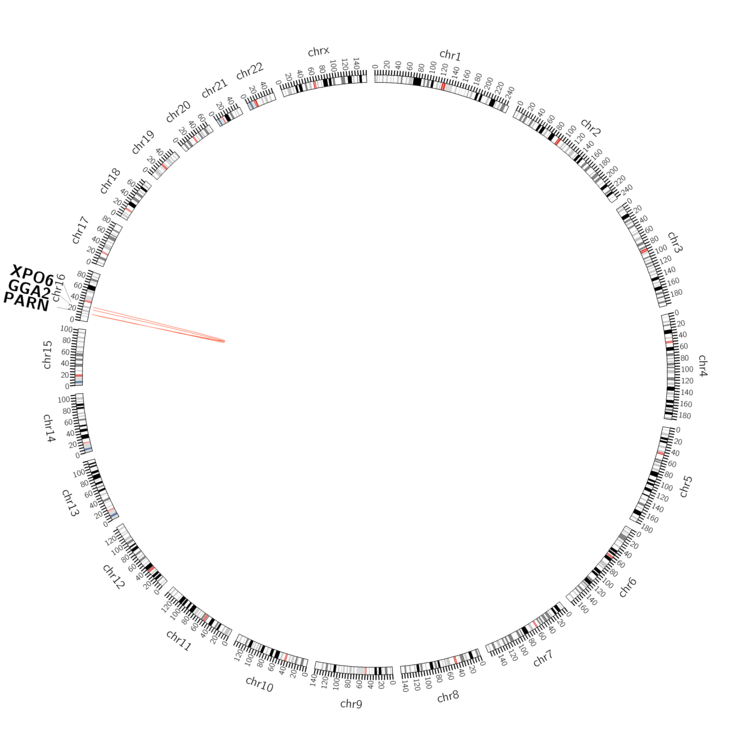 |
| - For Inter-chromosomal Variations |
| There's no inter-chromosomal structural variation. |
| - For Intra-chromosomal Variations |
| There's no intra-chromosomal structural variation. |
| Sample | Symbol_a | Chr_a | Start_a | End_a | Symbol_b | Chr_b | Start_b | End_b |
| breast | PARN | chr16 | 14553801 | 14553801 | GGA2 | chr16 | 23513083 | 23513083 |
| pancreas | PARN | chr16 | 14699833 | 14699853 | PARN | chr16 | 14708038 | 14708058 |
| pancreas | PARN | chr16 | 14707581 | 14707601 | XPO6 | chr16 | 28203100 | 28203120 |
| pancreas | PARN | chr16 | 14715600 | 14715620 | PARN | chr16 | 14697792 | 14697812 |
| cf) Tissue number; Tissue name (1;Breast, 2;Central_nervous_system, 3;Haematopoietic_and_lymphoid_tissue, 4;Large_intestine, 5;Liver, 6;Lung, 7;Ovary, 8;Pancreas, 9;Prostate, 10;Skin, 11;Soft_tissue, 12;Upper_aerodigestive_tract) |
| * From mRNA Sanger sequences, Chitars2.0 arranged chimeric transcripts. This table shows PARN related fusion information. |
| ID | Head Gene | Tail Gene | Accession | Gene_a | qStart_a | qEnd_a | Chromosome_a | tStart_a | tEnd_a | Gene_a | qStart_a | qEnd_a | Chromosome_a | tStart_a | tEnd_a |
| AW857210 | PARN | 105 | 354 | 16 | 14705270 | 14705648 | GOLPH3 | 349 | 554 | 5 | 32126215 | 32126420 | |
| DA139780 | ZNF587 | 2 | 209 | 19 | 58281039 | 58281246 | PARN | 208 | 580 | 16 | 14540758 | 14576686 | |
| AI207461 | CFB | 1 | 113 | 6 | 3251881 | 3252074 | PARN | 100 | 671 | 16 | 14565308 | 14565880 | |
| AW889901 | PARN | 40 | 231 | 16 | 14687420 | 14687611 | PARN | 227 | 500 | 16 | 14680135 | 14687347 | |
| BG572766 | PARN | 7 | 382 | 16 | 14704613 | 14723490 | MALAT1 | 372 | 740 | 11 | 65270148 | 65270515 | |
| AF130116 | CFB | 1 | 113 | 6 | 3251881 | 3252074 | PARN | 100 | 2438 | 16 | 14563544 | 14565880 | |
| AW889893 | PARN | 1 | 192 | 16 | 14687420 | 14687611 | PARN | 188 | 450 | 16 | 14680135 | 14687336 | |
| Top |
| Mutation type/ Tissue ID | brca | cns | cerv | endome | haematopo | kidn | Lintest | liver | lung | ns | ovary | pancre | prost | skin | stoma | thyro | urina | |||
| Total # sample | 1 | 1 | ||||||||||||||||||
| GAIN (# sample) | 1 | |||||||||||||||||||
| LOSS (# sample) | 1 |
| cf) Tissue ID; Tissue type (1; Breast, 2; Central_nervous_system, 3; Cervix, 4; Endometrium, 5; Haematopoietic_and_lymphoid_tissue, 6; Kidney, 7; Large_intestine, 8; Liver, 9; Lung, 10; NS, 11; Ovary, 12; Pancreas, 13; Prostate, 14; Skin, 15; Stomach, 16; Thyroid, 17; Urinary_tract) |
| Top |
|
 |
| Top |
| Stat. for Non-Synonymous SNVs (# total SNVs=30) | (# total SNVs=11) |
 |  |
(# total SNVs=0) | (# total SNVs=0) |
| Top |
| * When you move the cursor on each content, you can see more deailed mutation information on the Tooltip. Those are primary_site,primary_histology,mutation(aa),pubmedID. |
| GRCh37 position | Mutation(aa) | Unique sampleID count |
| chr16:14576651-14576651 | p.R505Q | 3 |
| chr16:14698008-14698008 | p.E260* | 2 |
| chr16:14530583-14530583 | p.D637D | 1 |
| chr16:14702917-14702917 | p.T206T | 1 |
| chr16:14576629-14576629 | p.Y512Y | 1 |
| chr16:14711476-14711476 | p.G120E | 1 |
| chr16:14687159-14687159 | p.A306V | 1 |
| chr16:14530615-14530615 | p.N627Y | 1 |
| chr16:14702941-14702941 | p.K198N | 1 |
| chr16:14711480-14711480 | p.Q119* | 1 |
| Top |
|
 |
| Point Mutation/ Tissue ID | 1 | 2 | 3 | 4 | 5 | 6 | 7 | 8 | 9 | 10 | 11 | 12 | 13 | 14 | 15 | 16 | 17 | 18 | 19 | 20 |
| # sample | 3 | 8 | 1 | 1 | 7 | 2 | 2 | 5 | 4 | 8 | ||||||||||
| # mutation | 3 | 8 | 1 | 1 | 7 | 2 | 2 | 5 | 5 | 9 | ||||||||||
| nonsynonymous SNV | 3 | 4 | 1 | 1 | 4 | 1 | 2 | 5 | 5 | 6 | ||||||||||
| synonymous SNV | 5 | 3 | 1 | 3 |
| cf) Tissue ID; Tissue type (1; BLCA[Bladder Urothelial Carcinoma], 2; BRCA[Breast invasive carcinoma], 3; CESC[Cervical squamous cell carcinoma and endocervical adenocarcinoma], 4; COAD[Colon adenocarcinoma], 5; GBM[Glioblastoma multiforme], 6; Glioma Low Grade, 7; HNSC[Head and Neck squamous cell carcinoma], 8; KICH[Kidney Chromophobe], 9; KIRC[Kidney renal clear cell carcinoma], 10; KIRP[Kidney renal papillary cell carcinoma], 11; LAML[Acute Myeloid Leukemia], 12; LUAD[Lung adenocarcinoma], 13; LUSC[Lung squamous cell carcinoma], 14; OV[Ovarian serous cystadenocarcinoma ], 15; PAAD[Pancreatic adenocarcinoma], 16; PRAD[Prostate adenocarcinoma], 17; SKCM[Skin Cutaneous Melanoma], 18:STAD[Stomach adenocarcinoma], 19:THCA[Thyroid carcinoma], 20:UCEC[Uterine Corpus Endometrial Carcinoma]) |
| Top |
| * We represented just top 10 SNVs. When you move the cursor on each content, you can see more deailed mutation information on the Tooltip. Those are primary_site, primary_histology, mutation(aa), pubmedID. |
| Genomic Position | Mutation(aa) | Unique sampleID count |
| chr16:14576651 | p.R459Q,PARN | 3 |
| chr16:14576608 | p.E473E,PARN | 2 |
| chr16:14530583 | p.N581Y,PARN | 1 |
| chr16:14711452 | p.S438Y,PARN | 1 |
| chr16:14576590 | p.F75C,PARN | 1 |
| chr16:14680212 | p.S579S,PARN | 1 |
| chr16:14530615 | p.M382I,PARN | 1 |
| chr16:14711473 | p.G74E,PARN | 1 |
| chr16:14687198 | p.I67V,PARN | 1 |
| chr16:14530619 | p.S579L,PARN | 1 |
| * Copy number data were extracted from TCGA using R package TCGA-Assembler. The URLs of all public data files on TCGA DCC data server were gathered on Jan-05-2015. Function ProcessCNAData in TCGA-Assembler package was used to obtain gene-level copy number value which is calculated as the average copy number of the genomic region of a gene. |
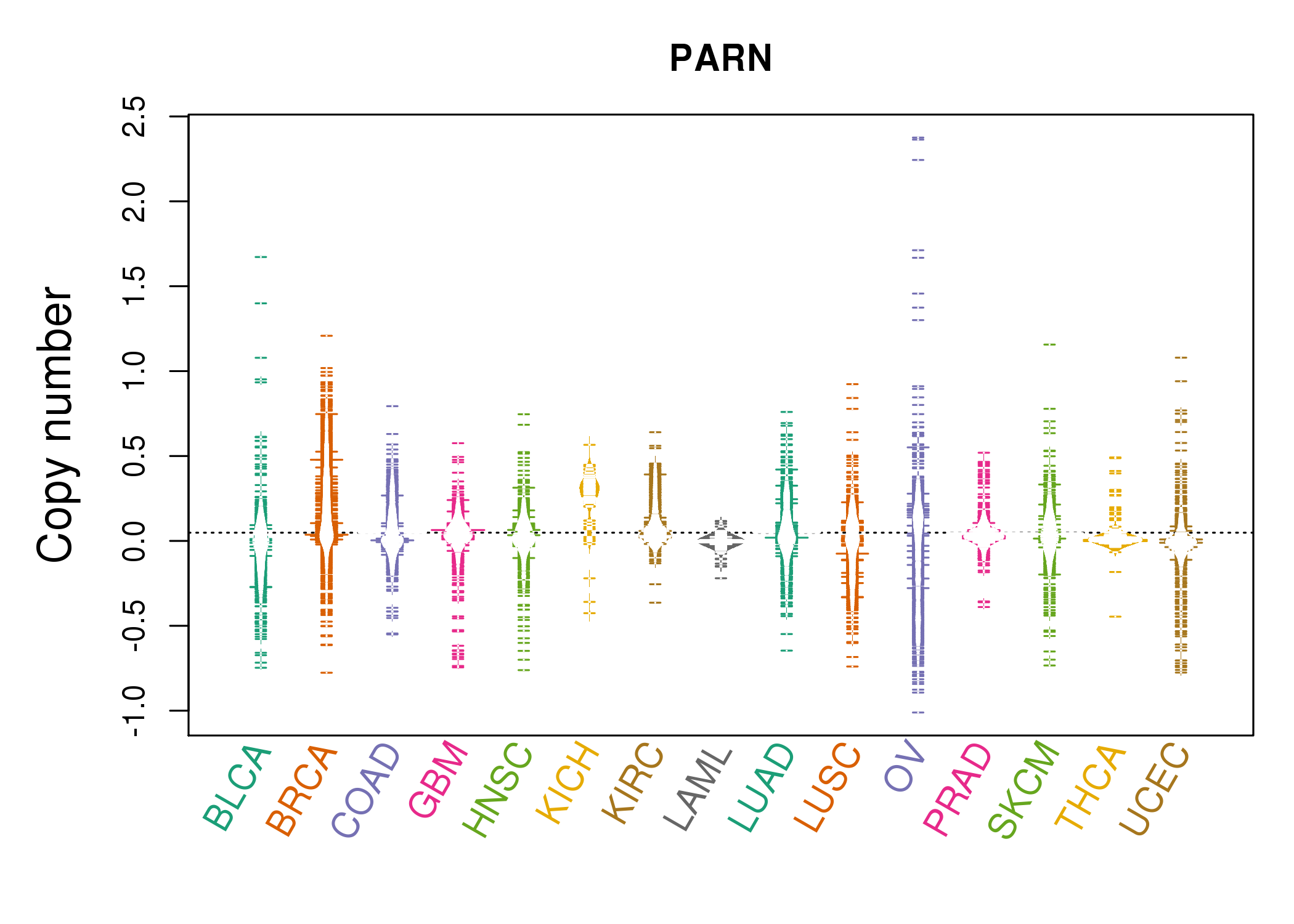 |
| cf) Tissue ID[Tissue type]: BLCA[Bladder Urothelial Carcinoma], BRCA[Breast invasive carcinoma], CESC[Cervical squamous cell carcinoma and endocervical adenocarcinoma], COAD[Colon adenocarcinoma], GBM[Glioblastoma multiforme], Glioma Low Grade, HNSC[Head and Neck squamous cell carcinoma], KICH[Kidney Chromophobe], KIRC[Kidney renal clear cell carcinoma], KIRP[Kidney renal papillary cell carcinoma], LAML[Acute Myeloid Leukemia], LUAD[Lung adenocarcinoma], LUSC[Lung squamous cell carcinoma], OV[Ovarian serous cystadenocarcinoma ], PAAD[Pancreatic adenocarcinoma], PRAD[Prostate adenocarcinoma], SKCM[Skin Cutaneous Melanoma], STAD[Stomach adenocarcinoma], THCA[Thyroid carcinoma], UCEC[Uterine Corpus Endometrial Carcinoma] |
| Top |
| Gene Expression for PARN |
| * CCLE gene expression data were extracted from CCLE_Expression_Entrez_2012-10-18.res: Gene-centric RMA-normalized mRNA expression data. |
 |
| * Normalized gene expression data of RNASeqV2 was extracted from TCGA using R package TCGA-Assembler. The URLs of all public data files on TCGA DCC data server were gathered at Jan-05-2015. Only eight cancer types have enough normal control samples for differential expression analysis. (t test, adjusted p<0.05 (using Benjamini-Hochberg FDR)) |
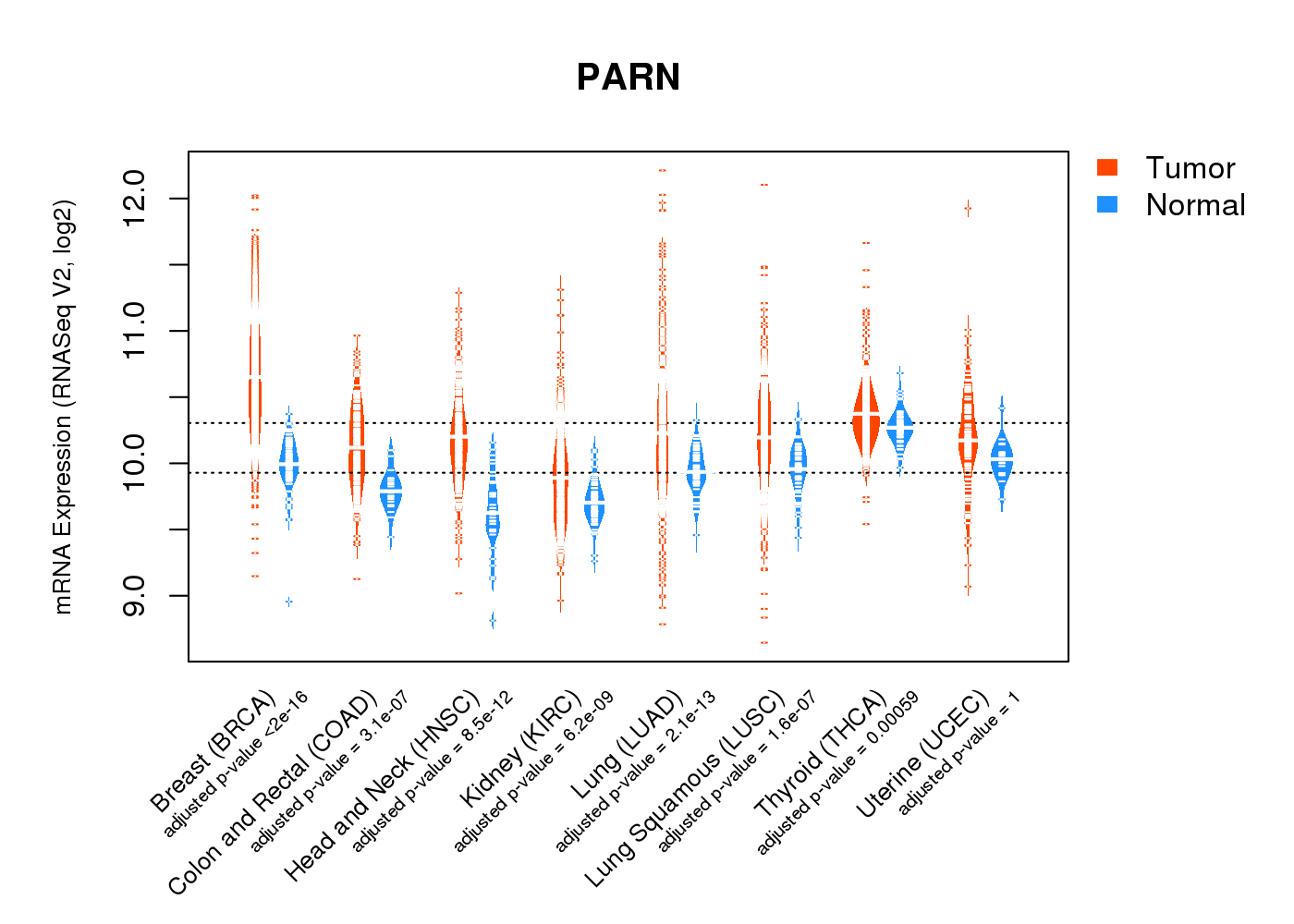 |
| Top |
| * This plots show the correlation between CNV and gene expression. |
: Open all plots for all cancer types
 |
|
 |
|
| Top |
| Gene-Gene Network Information |
| * Co-Expression network figures were drawn using R package igraph. Only the top 20 genes with the highest correlations were shown. Red circle: input gene, orange circle: cell metabolism gene, sky circle: other gene |
: Open all plots for all cancer types
 |
|
| BFAR,C16orf62,FOPNL,C16orf72,KNOP1,CLUAP1,COG7, COQ7,EARS2,ERI2,GSPT1,HN1L,IQCK,LYRM1, PARN,RNF40,RRN3,THUMPD1,USP7,ZNF174,ZSCAN32 | AP1M2,APTX,ARFIP2,C1orf210,COG7,CSTF3,DLG3, EIF2AK1,EPCAM,EXOSC10,SPIDR,NIPSNAP1,NVL,PARN, SEC23B,SUSD4,NELFCD,THADA,UMPS,XRCC5,ZNF544 |
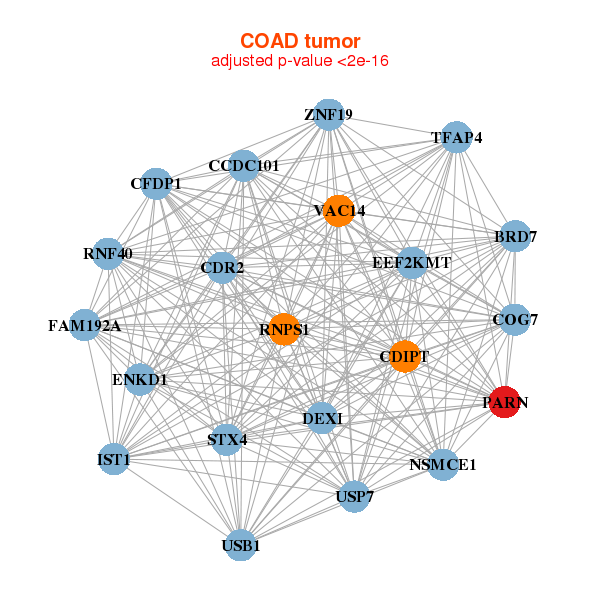 |
|
| BRD7,ENKD1,USB1,CCDC101,CDIPT,CDR2,CFDP1, COG7,DEXI,FAM192A,EEF2KMT,IST1,NSMCE1,PARN, RNF40,RNPS1,STX4,TFAP4,USP7,VAC14,ZNF19 | CNOT4,DYNLL2,DYRK1A,EIF4H,GRB2,HNRNPUL1,HNRNPUL2, HTATSF1,KIDINS220,KAT6A,PAF1,PARN,RAB3GAP1,RSF1, SNRNP200,SUPT6H,TAF15,THRAP3,UPF2,WDR7,ZNF407 |
| * Co-Expression network figures were drawn using R package igraph. Only the top 20 genes with the highest correlations were shown. Red circle: input gene, orange circle: cell metabolism gene, sky circle: other gene |
: Open all plots for all cancer types
| Top |
: Open all interacting genes' information including KEGG pathway for all interacting genes from DAVID
| Top |
| Pharmacological Information for PARN |
| There's no related Drug. |
| Top |
| Cross referenced IDs for PARN |
| * We obtained these cross-references from Uniprot database. It covers 150 different DBs, 18 categories. http://www.uniprot.org/help/cross_references_section |
: Open all cross reference information
|
Copyright © 2016-Present - The Univsersity of Texas Health Science Center at Houston @ |







